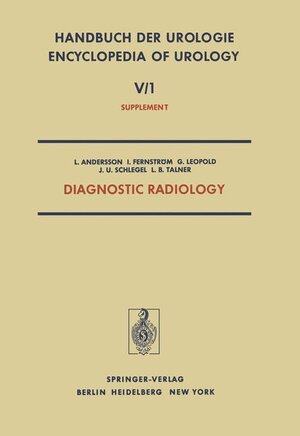
×
![Buchcover ISBN 9783540078968]()
Diagnostic Radiology
Radionuclides in Urology - Urological Ultrasonography - Percutaneous Puncture Nephrostomy
von L. Andersson, I. Fernström, G.R. Leopold, J.U. Schlegel und L.B. TalnerInhaltsverzeichnis
- Radionuclides in Urology.
- A. Introduction.
- B. Renal Clearances.
- C. Renal Function Studies with External Scintillation Probe.
- D. Renal and Urinary Tract Function Utilizing a Gamma Scintillation Camera.
- E. Renal Failure.
- F. Hydronephrosis.
- G. Renal Hypertension.
- H. Renal Transplantation.
- J. Radionuclides in the Pediatric Patient.
- K. Radionuclides in Bladder Pathology Including Vesicoureteral Reflux.
- Vesicoureteral Reflux.
- L. Renal Tumors.
- M. Injuries.
- N. Miscellaneous Subjects.
- I. Testes.
- II. Prostate.
- III. Adrenals.
- IV. Bone.
- V. Lungs.
- VI. Thrombophlebitis.
- References.
- Urological Ultrasonography.
- B. Basic Principles.
- I. Physics.
- II. A-Mode Display.
- III. B-Mode and Gray Scale.
- C. Method of Examination.
- D. Normal Anatomy.
- I. Kidney-Transverse Anatomy.
- II. Kidney-Sagittal Anatomy.
- III. Bladder.
- E. Clinical Applications.
- IV. Perirenal Masses.
- 1. Cysts.
- 2. Percutaneous Cyst Puncture.
- 3. Complex or Solid Masses.
- II. Renal Biopsy.
- III. Perirenal Fluid Collections.
- V. Hydronephrosis.
- VI. Renal Transplants.
- VII. Urinary Bladder.
- 1. Bladder Volumes.
- 2. Bladder Tumors.
- 3. Prostatic Scanning.
- Summary.
- Percutaneous Puncture Nephostromy.
- B. Operative Nephrostomy.
- C. Percutaneous Puncture of the Renal Pelvis.
- D. The Principle of Percutaneous Puncture Nephrostomy.
- I. Instruments.
- II. Anesthesia.
- III. The Technique of Percutaneous Puncture Nephrostomy.
- 1. Puncture and Introduction of a Polyethylene Tube Into the Renal Pelvis.
- 2. Dilatation of the Nephrostomy Canal.
- 3. Insertion of Foley-Type Catheter.
- 4. Inflation of the Balloon.
- IV. Duration of Catheter Drainage.
- V. Accidental Extrusion of a Tube.
- VI. Accidental Extrusion of a Foley Catheter.
- VII. Permanent Nephrostomy.
- E. General Aspects on the Indications for Puncture Nephrostomy.
- I. Unilateral Obstruction With Normal Contralateral Kidney.
- II. Ureteric Obstruction in a Solitary Kidney or With Malfunction of the Contralateral Kidney.
- III. Bilateral Ureteric Obstruction.
- F. Special Indications for Nephrostomy.
- I. Operative Damage to a Ureter.
- II. The Ureter Blocked by a Calculus.
- III. Ureteric Stricture Following Urogenital Tuberculosis.
- IV. Retroperitoneal Fibrosis.
- V. Ureteric Obstruction in Malignant Disease.
- VI. The Contracted Bladder With Necrosis and Fistula Formation.
- VII. Postoperative Complications Following Urinary Diversion.
- G. Ureteric Obstruction Complicated by Infection.
- H. Removal of Renal Calculi by Percutaneous Renal Puncture.
- J. Complications of Puncture Nephrostomy.
- I. Hemorrhage.
- II. Pain.
- III. Infection.
- IV. Accidental Penetration of Nonrenal Organs.
- V. Inadequate Drainage.
- VI. Disturbances of Renal Function.
- Author Index.




